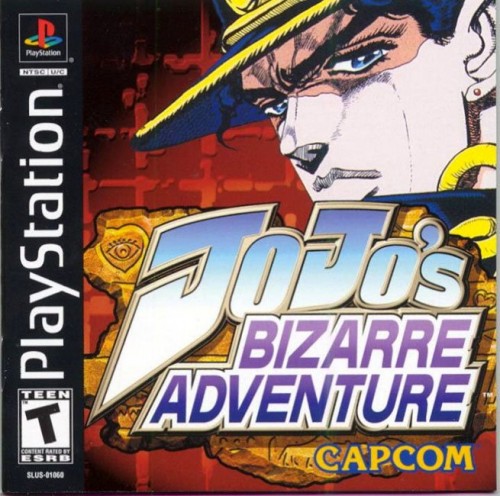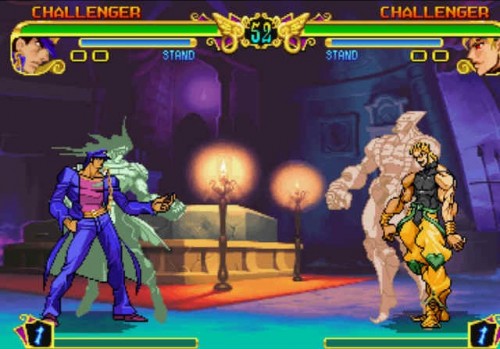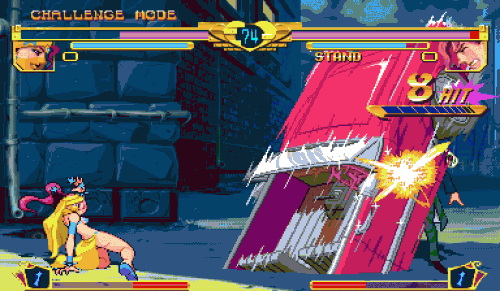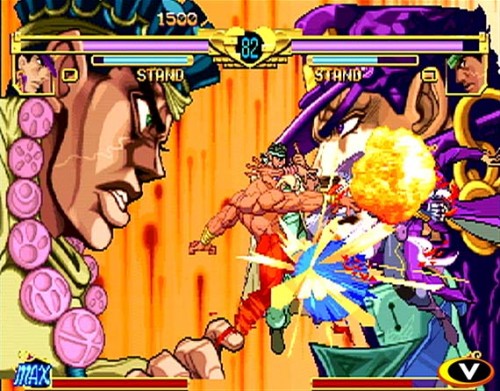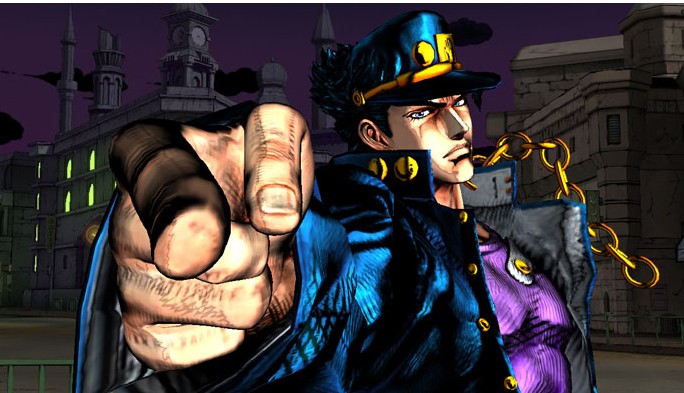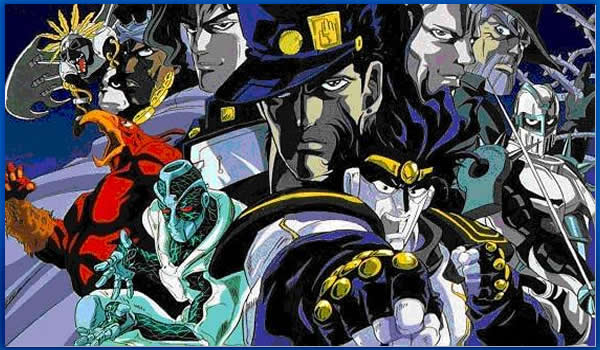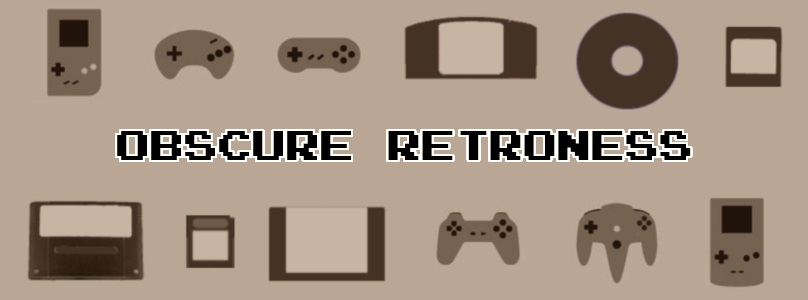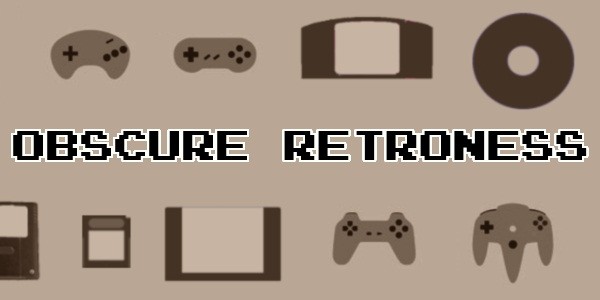
Welcome to the second installment of Obscure Retroness! Capcom and fighting game fans rejoice, because today we’re going to pick at one of their finest video game adaptations: JoJo’s Bizarre Adventure for the Sony PlayStation and Sega Dreamcast (previously available in the arcades as well). Expect a lot of use of the word ‘fabulous’.
JoJo’s Bizarre Adventure is a long-running manga series created by Hirohiko Araki, and is currently split into eight parts, each featuring a different story and a protagonist with a name that can be shortened to ‘JoJo’. The series is hugely popular in Japan, renowned for its flamboyant character designs, over-the-top violence, incredibly clever battles and for naming a great deal of its characters after songs, bands, fashion labels, tarot cards or Egyptian gods. (The name ‘JoJo’ stems from the Beatles song, ‘Get Back’.) While JoJo is relatively obscure in the Western world, the internet-savvy have probably encountered a certain meme featuring the big bad of the game. This game corresponds to Part 3, rather fabulously subtitled Stardust Crusaders. Part 3 tells the story of Jotaro Kujo, a young man who suddenly discovers he has supernatural power manifesting itself in the form of a man floating beside him. As it turns out, several others have similar powers, named by Jotaro’s grandfather, Joseph Joestar (Part 2’s protagonist and the most badass old man ever), as Stands. What starts off as a rather casual investigation turns into a race against time as Jotaro’s mother develops a Stand that is slowly killing her. They pinpoint the cause of the Stand development to Dio Brando, an old enemy of the Joestar family, who resides in Egypt. With fortune teller Avdol and Kakyoin, a former foe, they set off on a worldwide trek to stop Dio. Along the way they gather two more companions: J.P. Polnareff, a Frenchman out for revenge and Iggy, a Boston terrier with a terrible attitude.
Given the premise of the series, it’s interesting to see how Capcom has adapted the characters, the Stands and the amazing battles into a versus fighting game. Apart from standard punches and kicks, the core part of the game’s mechanic is being able to summon your Stand on a whim and therefore increasing your repertoire of moves and combos. As you might expect, each of the characters’ Stands have different abilities. For example, Jotaro’s Star Platinum is a powerhouse but is quite slow in-game, while Kakyoin’s Hierophant Green has great defensive capabilities and long reach. Then there are characters with passive Stands, such as Joseph and his Hermit Purple, which is essentially a more typical integration of special abilities into the character’s existing moveset. The movesets and abilities of the protagonists and their Stands are fairly simple, which is understandable given the nature of the manga’s scenarios. The villains’ Stands on the other hand, are what make the game truly shine. You see, throughout the manga, Araki got creative with the villains, giving them Stand powers that didn’t necessarily mean having a fist-to-fist showdown. Big bad Dio and his Stand, The World, are similar to Jotaro and Star Platinum in the sense that they have a powerful arsenal of moves, but with the key ability to stop time as well. In contrast you have a character like Hol Horse, whose Stand is The Empress, a gun with the ability to fire bullets in any direction. The manga saw him teaming up with various characters because the nature of his stand made it impossible for him to confront Jotaro’s party alone. While this obviously isn’t something that can be replicated in the game, Hol’s play focuses very much on mind games to catch the player off-guard, which reflects well on his personality and abilities in the source material. Then there’s Alessi (my favourite character adaption in the game) whose Stand, Seth, is a shadow that turns people into children if they stand in it for too long. In the game, Seth, while flat on the ground, is able to stick his hands out and attack the other players with weapons such as axes. His age-decreasing ability is only activated upon pulling off a special, which lends itself well to balance.
With the roster’s incredible range of capabilities, it means a lot of strategic thinking, much like in the Guilty Gear or Blazblue series. Another thing that I love about JoJo is the rare, but insanely awesome Blazing Fists Match. It occurs when certain characters pull off certain special moves at the same time, prompting the players to bash buttons as quickly as possible to decide who receives the damage. It’s well within the spirit of the manga, even going so far as to fill the screen with the character’s battle cries. If you’re a fan of Fist of the North Star, you’ll know what to expect. The PlayStation and Dreamcast versions also feature the rather excellent Super Story Mode, which takes players through most of the manga arc. This is more than just your standard Arcade mode as it intersperses adventure, action, puzzle and even a couple of quick-time events with the versus matches. It’s a great opportunity for Capcom to show off how they thought each encounter through from a video game perspective, which is impressive because in a lot of cases it would have been impossible to throw these events into a typical fighting game. Take the encounter with D’Arby the Gambler, for example – the manga sees him challenging Joseph to a game of putting coins into a glass of water while avoiding any spillage (with the wager being Joseph’s soul). This was turned into a minigame that took the factors of the challenge into play, such as how many coins to add and a gauge measuring the balance of the surface tension and how to drop the coins in. Super Story Mode is a great addition to an already worthwhile package, and a wonderful incentive for PlayStation and Dreamcast owners.
With JoJo’s Bizarre Adventure being incredibly dear to my heart and fighting games being one of my favourite genres, it’s pretty obvious that this game is one of my favourites. What I’d really love to see in the future is a fighting game made by Arc System Works starring a giant cast of JoJo characters from each of the parts. For now though, I make do with the other games that were released; a Part 3 RPG for the Super Famicom, an action-adventure game based on Part 5 and a beat ‘em up based on Part 1 (both for the PlayStation 2). It goes without saying that anyone interested in action and clever storylines, should check JoJo out. To wrap it up, here’s my favourite track from the awesome soundtrack:
[youtube id=”WdoEK4gjOVA” width=”600″ height=”350″]
Oh, I didn’t use the word ‘fabulous’ that much? Well, isn’t that fabulous!

